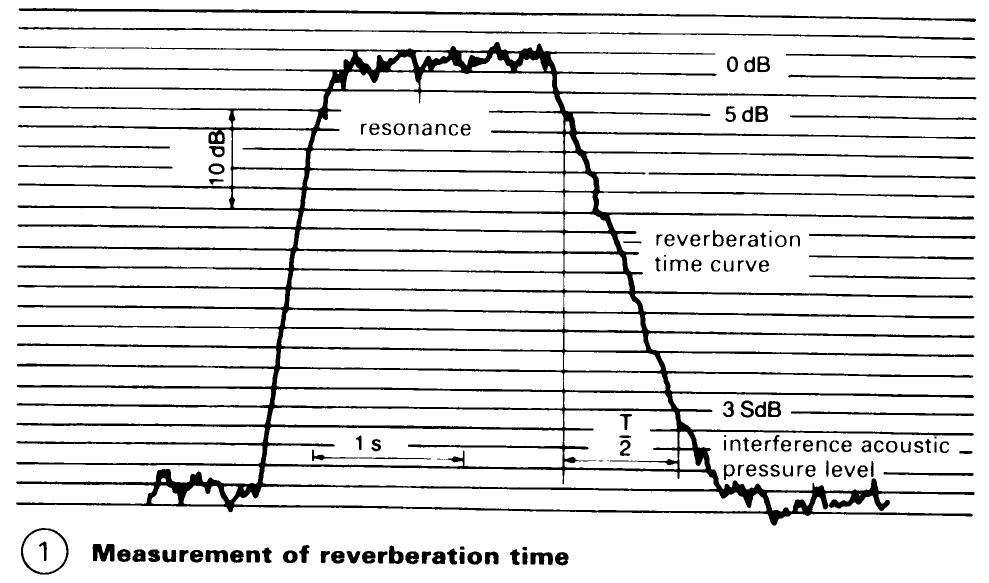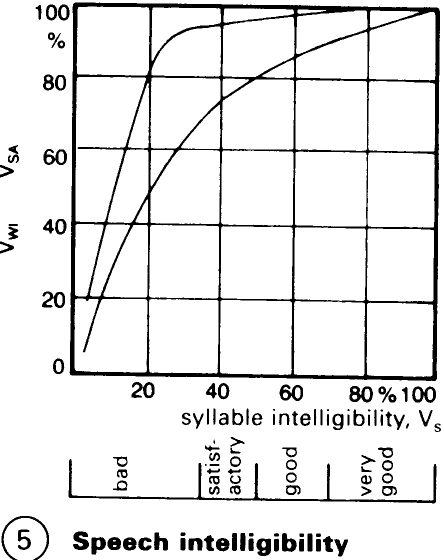Room Acoustic. Requirements for Rooms
Room acoustic planning should ensure that optimum audible conditions are created for listeners in rooms where speech and music are to be carried out. Various factors should be considered, of which the two most important are reverberation time, and reflections (as a consequence of the primary and secondary structure of the room).
(1). Reverberation time. This is the time taken for the decay of a noise level of 60dB after the sound source has been switched off (1). Evaluation is carried out over the range -5 to -35dB.

(2). Absorption surface. The absorption surface is determined by the amount of absorbing material, expressed as an area having complete absorption (open window):
![]()
where as is the degree of sound absorption from echo chamber measurements, and S is the area of surface portion.
The reverberation time is calculated from the absorption surface from:
![]()
(3). Echoes. When individual, subjectively recognisable peaks are superimposed on a smoothly falling reverberation time curve – (1), these are described as echoes - (2). Various values of time and intensity apply as the echo criterion for speech and music. Rooms devoted to music should have a longer reverberation time, but are usually regarded as less critical from the point of view of echoes.

Requirements for rooms. (1). Reverberation time. The optimum value for reverberation time is dependent on the particular use and room volume - (3). In general, reverberation time is frequency-dependent (longer at low frequencies, shorter at high frequencies.) For f = 500Hz, surveys have shown that approximations may provide optimum values – (4).


(2). Speech intelligibility. This is used to judge the degree of audibility of the spoken word – (5). It is not standardised, so various terms - sentence intelligibility, syllable intelligibility, evaluation with logatomes - are usual. In determining the intelligibility of speech, a number of collectively heard individual syllables of no significance (logatomes such as lin and ter) are noted; the correctness is used to make an assessment - a score of more than 70% implies excellent speech intelligibility. Newer, objective, methods make use of modulated noise signals (RASTI method) and lead to reproducible results at low expense.

(3). Impression of space. This is determined by the reception of reflections with respect to time and direction. For music, diffuse reflections are favourable for sound volume, while early reflections with delays of up to 80ms (corresponding to 27 m path difference) with respect to the direct sound promote clarity - (6). Speech requires shorter delays (up to 50ms) so as not to degrade the intelligibility.

For the music listener, early sideways reflections are better than ceiling reflections, even at very low delay times (asymmetry of the acoustic impression), since each ear receives a different signal. Narrow, high rooms with geometrically reflecting walls with multiple angles and diffusely reflecting ceilings are the simplest from the point of view of room acoustics.
Date added: 2023-01-05; views: 647;
